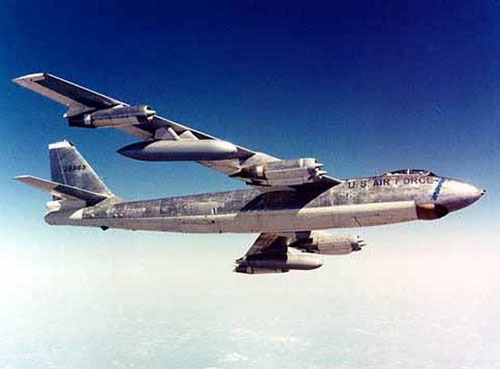B-47 Stratojet
Summary
| Category | Bombers |
| Origin country | 🇺🇸 United States |
| Manufacturer | Boeing |
| First flight | 17 December 1947 |
| Year introduced | 1952 |
| Number produced | 2042 units |
| Average unit price | $3 million |
Description
The B-47's development began with a 1943 United States Army Air Forces (USAAF) requirement for a jet-powered reconnaissance bomber, intended to prompt manufacturers to research jet bombers. Boeing responded, among other companies, with the Model 424, a scaled-down B-29 Superfortress with four jet engines. This concept evolved into a formal 1944 request for a new bomber with specified speed, range, and ceiling capabilities. Boeing's initial design, the Model 432, featured four engines buried in the forward fuselage. Captured German research confirming the benefits of swept-wing designs for high-speed flight prompted a significant innovation. Boeing modified its design, leading to the Model 450, which featured engines in streamlined pylon-mounted pods under the wings and at the wingtips. This configuration resulted in a contract for two prototypes, designated "XB-47," in April 1946. The first XB-47 made its maiden flight on 17 December 1947, and after prevailing in competitions with designs such as the North American XB-45, Convair XB-46, and Martin XB-48, a contract for 10 B-47A bombers was signed on 3 September 1948.
The XB-47 featured a sleek design with 35-degree swept, shoulder-mounted wings. Inboard turbojet engines were mounted in twin pods at about a third of the span, while outboard engines were mounted singly near the wing tip. This arrangement reduced the bending moment at the wing roots, conserving structural weight, and the engine mass served as counter-flutter weights. The wing airfoil was identified by Boeing as the BAC 145, also known as the NACA 64A(.225)12 mod airfoil. Wing flexibility was notable, with the tip flexing as much as 17.5 ft (5.3 m). The flight control surfaces were powered, augmenting pilot inputs and reducing exertion required to overcome aerodynamic forces. The aircraft was designed to carry a crew of three in a pressurized forward compartment: a pilot and copilot, in tandem, in a long fighter-style bubble canopy, and a navigator/bombardier in a compartment in the nose. The bubble canopy pitched up and slid backward, providing high visibility to the pilots. Heaters and refrigeration systems were present in the cockpit to manage the crew environment.
The B-47 could carry a bombload of up to 25,000 lb (11,340 kg). This could include two Mk15 nuclear bombs or four B28 nuclear bombs. Other nuclear ordnance options were a single B41 or a single B53 nuclear bomb. The aircraft was also capable of carrying 28 × 500 lb (227 kg) conventional bombs. Defensive armament consisted of two 20 mm (0.787 in) M24A1 autocannon in a remote-controlled tail turret.
The USAF Strategic Air Command (SAC) operated multiple B-47 models from 1951 through 1965. Upon entry into service, its performance was closer to that of contemporary fighters than SAC's extant B-36 Peacemaker bomber. The B-47 handled well in flight, the controls having a fighter-like light touch. The large bubble canopy enhanced the flying crew's vision but also caused internal temperature variations. The three-man crew consisted of the commander, copilot, and a navigator/bombardier or a crew chief. The B-47 became operational in 1953. It was characterized as sluggish on takeoff and too fast on landings; improper landing angle could cause "porpoising." Low-altitude speed restrictions were necessary due to wing flex. Early mission profiles included the loft bombing of nuclear weapons; improved training eventually led to a good safety record. By 1956, the USAF operated 28 wings of B-47 bombers and five wings of RB-47 reconnaissance aircraft, often operating from forward bases in locations such as the UK, Morocco, Spain, Alaska, Greenland, and Guam. Stress and fatigue from low-altitude operations led to wing failures and crashes, prompting an extensive refit program starting in 1958 to strengthen wing mountings. The final phaseout of B-47 bomber wings began during 1963, with the last removed from SAC service by 1966. The last USAF operational aircraft, WB-47Es assigned to the Air Weather Service, were withdrawn from use in September 1969. The aerial reconnaissance variants were the only B-47s to perform missions approaching combat, probing Soviet airspace from various airfields.
Main Variants:
-
XB-47: The initial prototype aircraft, powered by six Allison J-35-GE-7 turbojet engines, later retrofitted with General Electric J-47-GE-3 engines, serving as a testbed for the swept-wing design.
-
B-47A: The first 10 evaluation aircraft, powered by J47-GE-11 turbojets and featuring built-in rocket-assisted-take-off (RATO) bottles, with some fitted with advanced bombing and navigation systems.
-
B-47B: The first operational model, with uprated J47-GE-23 engines, full combat systems, a shorter bomb bay, a tail turret with twin 20 mm guns, and a nose-mounted in-flight refueling (IFR) receptacle.
-
TB-47B: A trainer variant converted from non-combat B-47Bs, with a fourth seat for an instructor and the tail turret removed, used for training through the 1950s.
-
RB-47E: A reconnaissance model with a stretched nose accommodating up to 11 cameras, increased fuel capacity, and the ability to be refueled in flight, used for probing Soviet airspace.
Technical specifications
| Version: B-47E | |
|---|---|
| Crew | 3 members |
| Operational range | 3,240 km (2,013 mi) |
| Maximum speed | 977 km/h (607 mph) |
| Wing area | 132.7 m² (1428.4 sqft) |
| Wingspan | 35.4 m (116.0 ft) |
| Height | 8.5 m (28.0 ft) |
| Length | 32.7 m (107.1 ft) |
| Service ceiling | 10,089 m (33,100 ft) |
| Empty weight | 35,867 kg (79,073 lbs) |
| Max. takeoff weight | 100,000 kg (220,462 lbs) |
| Climb rate | 23.7 m/s (77.8 ft/s) |
| Powerplant | 6 x turbojets General Electric J47-GE-25 delivering 3266 kgf each |
Current operating countries
All operators
Armament
Bombs payload:
- Thermonuclear Mk 15

